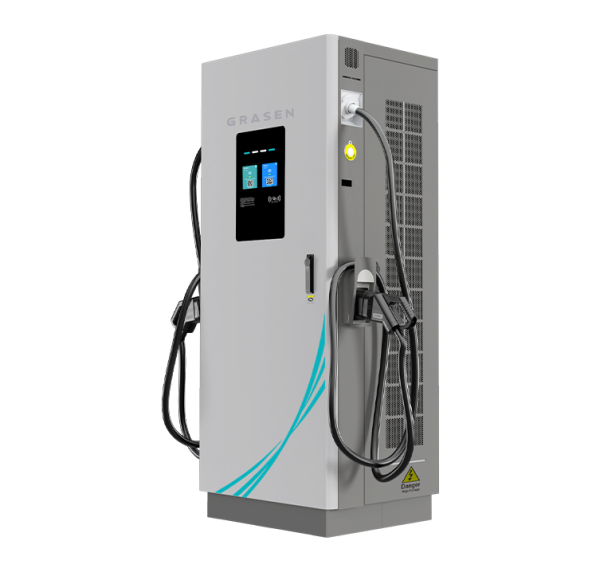As the world shifts toward sustainable and eco-friendly transportation solutions, electric vehicles (EVs) have emerged as the front-runners in reducing emissions and reliance on fossil fuels. However, one major challenge that has limited the widespread adoption of electric vehicles is the time required to charge them. Traditional charging methods, such as Level 1 and Level 2 chargers, can take several hours to charge an EV fully, making long trips less convenient. Enter the DC Fast Charger, a game-changing technology designed to dramatically reduce charging time and accelerate the EV revolution.
What is a DC Fast Charger?
A DC Fast Charger (DCFC) is a high-speed charging system that supplies direct current (DC) power to an electric vehicle, as opposed to the alternating current (AC) used by most conventional chargers. The key difference lies in the method of power delivery. While AC chargers rely on the vehicle’s onboard charger to convert AC power to DC power, DC Fast Chargers bypass the vehicle’s charger and deliver DC power directly to the battery, significantly speeding up the charging process.
DC Fast Chargers typically operate at a much higher voltage (typically 400V to 900V) and can provide power in the range of 50 kW to 350 kW or more. This allows for rapid charging, enabling EVs to gain hundreds of miles of range in under an hour, a significant improvement compared to the long charging times associated with standard chargers.
Benefits of DC Fast Chargers
- Speed: The most obvious advantage of DC Fast Chargers is their speed. With a DCFC, you can charge an EV to 80% capacity in about 30 minutes, depending on the vehicle and the charger’s power output. This makes it possible for EV owners to quickly recharge during road trips or while on the go, reducing the downtime typically associated with EV charging.
- Convenience: DC Fast Chargers are ideal for public charging stations, especially along highways and busy routes. They make long-distance travel more feasible, eliminating “range anxiety,” the fear that your EV will run out of charge before reaching the next charging station.
- Reduction in Charging Time: For fleet operators, commercial vehicles, and businesses with electric vehicles, DCFC stations can save valuable time. With faster turnaround times for charging, businesses can optimize their operations without prolonged downtime for charging.
- Grid Efficiency: Modern DC Fast Chargers are designed to be more energy-efficient, using technologies that minimize energy losses during the charging process. This contributes to a more sustainable power grid by reducing the overall demand on energy resources.
How Does a DC Fast Charger Work?
DC Fast Chargers work by converting AC power from the electrical grid to DC power, which is then directly sent to the vehicle’s battery. The vehicle’s battery management system communicates with the charging station to regulate the charging speed, ensuring that the battery is charged safely and efficiently.
Charging typically occurs in three stages:
- Initial Charge: The charger begins by delivering a high amount of current to the battery to charge it quickly.
- Top-off Charge: As the battery nears 80%, the charging speed is gradually reduced to protect the battery from overheating and overcharging.
- Final Charge: The last 20% is charged more slowly to avoid damaging the battery and to ensure the battery’s longevity.
DC Fast Chargers utilize different charging connectors, including:
- CHAdeMO: A Japanese-developed standard that supports fast charging for various EVs, including Nissan, Mitsubishi, and others.
- CCS (Combined Charging System): A popular standard in Europe and the United States, used by major manufacturers like BMW, Mercedes-Benz, and Volkswagen.
- Tesla Supercharger: A proprietary fast-charging network designed for Tesla vehicles, offering high-speed charging capabilities.
The Future of DC Fast Charging
As the demand for electric vehicles continues to rise, the infrastructure for DC Fast Chargers will need to expand rapidly to keep up. Innovations in battery technology, such as solid-state batteries, may lead to even faster charging times and improved energy density. Additionally, wireless charging solutions, which could eliminate the need for physical connectors, are on the horizon, potentially revolutionizing how we charge EVs.
Governments and private companies are heavily investing in expanding DCFC networks worldwide. These efforts are crucial for making electric vehicles more accessible to the masses and ensuring the viability of EVs as a mainstream mode of transportation.
Furthermore, the widespread adoption of renewable energy sources such as solar and wind can power these charging stations, creating a sustainable ecosystem where clean energy is used to recharge EVs.
Conclusion
DC Fast Chargers are undoubtedly a key player in the transition to a greener, more sustainable transportation system. By offering faster charging times, increased convenience, and supporting long-distance travel, DCFCs are helping make electric vehicles a practical and viable option for everyday drivers.
